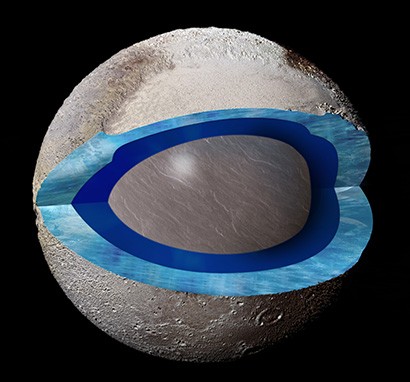By Ana Verayo, | November 17, 2016

This cutaway image of Pluto shows a section through the area of Sputnik Planitia, with dark blue representing a subsurface ocean and light blue for the frozen crust. (Pam Engebretson/UC Santa Cruz)
Pluto could have an ocean deep underneath its frozen "heart," according to a new study. Planetary scientists suggest that the frozen planet may have "rolled over on its axis" due to the powerful tidal forces from its largest moon, Charon.
Scientists from the University of California, Santa Cruz, analyzed new observations obtained from NASA's New Horizons spacecraft which successfully completed a historic flyby of the dwarf planet last July 2015. The scientists discovered that an underground ocean may have also formed the famous feature of the planet, Pluto's icy heart.
Like Us on Facebook
This heart-shaped region known as Sputnik Planitia could be hiding a massive ocean underneath it. Scientists also say that Charon's gravitational forces on Pluto are stronger than ever since they are perpetually locked in alignment.
Pluto is not the only alien world in the solar system with an underground ocean, some moons of Jupiter and Saturn also have global oceans, which can suggest potential life.
However, this ocean is unlike anything on Earth, since it is composed of ammonia and other "antifreeze" elements mixed with water. The consistency is probably not fluid or wet enough, but more of slushy chunks of ice. This alien ocean can also run more than 62 miles deep, according to planetary scientist Francis Nimmo of the University of California, Santa Cruz.
Even if Pluto is more than three billion miles away from the sun, the dwarf planet can generate its heat from radioactive energy building up within its interior. This also makes the water its underground ocean liquid.
Nimmo added that these subsurface oceans might also exist on other dwarf planets and planetoids in the Kuiper Belt region, which is the region in our solar system beyond Neptune that is filled with icy rocks and asteroids. He noted that these worlds could become interesting discoveries, making them not just frozen snowballs.
This new study was published in the journal Nature.
-
Use of Coronavirus Pandemic Drones Raises Privacy Concerns: Drones Spread Fear, Local Officials Say

-
Coronavirus Hampers The Delivery Of Lockheed Martin F-35 Stealth Fighters For 2020

-
Instagram Speeds Up Plans to Add Account Memorialization Feature Due to COVID-19 Deaths

-
NASA: Perseverance Plans to Bring 'Mars Rock' to Earth in 2031

-
600 Dead And 3,000 In The Hospital as Iranians Believed Drinking High-Concentrations of Alcohol Can Cure The Coronavirus

-
600 Dead And 3,000 In The Hospital as Iranians Believed Drinking High-Concentrations of Alcohol Can Cure The Coronavirus

-
COVID-19: Doctors, Nurses Use Virtual Reality to Learn New Skills in Treating Coronavirus Patients







